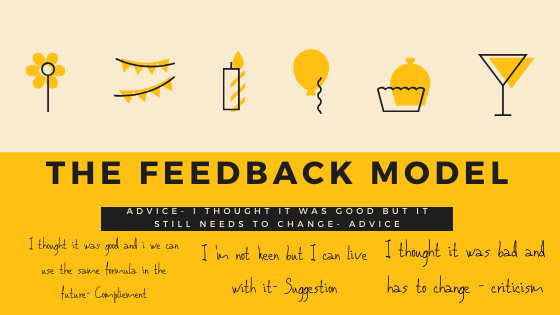How do you give feedback, or deal with other people’s complaints and criticism
Giving or receiving feedback can be challenging , and sometimes difficult if the feedback comes across as negative it’s easy to hurt people’s feelings. People talk about constructive criticism, but this can damage your colleagues self esteem. What about only giving positive feedback to avoid confrontation? Hmm, fake compliments are not good either, as you might come across as fake or insincere.
Dealing with Feedback
In life we will get feedback that is both good and bad, its what we do with this that’s important. Don’t dwell on what you found good or bad, this ins’t the main takeaway for using feedback constructively. Instead, ask yourself what you can do with this criticism (if negative). What will you do in the same way if you were to do it again and what needs to change.
Giving feedback
Source HBR– What good feedback really looks like
- Harsh FB does not help people thrive and excel. Indeed, effective criticism needs to be delivered with respect and care. Frequent or exclusively negative comments can spark defensive reactions that cloud perceptions and dampen motivation.
- Positive FB is critical for learning. People are often quick to notice what’s wrong, but it’s equally important to pay attention to and provide input on what is working to support development.
- Telling someone how to fix a problem is often the wrong approach. You’ll foster more learning by asking questions that stimulate reflection and coaching people into exploration and experimentation.
However, we disagree with other points:
- People are unreliable assessors of others and thus give feedback that is more distortion than truth. Feedback is never purely objective since it is delivered from a human being with a unique perspective. However, for a leader, knowing how others see and experience her is incredibly valuable since those people make decisions based on their perceptions—decisions about who to listen to, cooperate with, trust, support and promote.
- Feedback about weaknesses creates a threat that inhibits learning. Research indicates that 360-feedback recipients who get unfavorable ratings tend to improve their performance more than others. And, in CCL’s work, we’ve found successful executives credit all types of potentially threatening events (e.g., horrible bosses, making a business mistake, being demoted, and firing employees) as key drivers of their development.
- People should just focus on their strengths. Our work has shown that ignoring one’s weaknesses is one of the greatest contributors to individual derailment in organizations. No matter how well-tuned a leader’s strengths are, one unaddressed “fatal flaw” (e.g., arrogance, inability to build a team or difficulty adapting to a new context) can lead to failure — particularly if it is unacknowledged by the individual.
- You can best help your organization by getting better at the things you are already good at. This assumes that everyone is already good at the right things — that they have the critical skills and competencies that organizations need to succeed. Our colleague Jean Leslie’s research demonstrates that this is rarely the case. In fact, she found that leaders are weakest in the four most important future leadership skills—inspiring commitment, leading employees, strategic planning and change management.
When you focus only on strengths, you lull people into believing there are no areas in which they need to improve. It also lets managers off the hook for fostering necessary — and sometimes difficult — development in their reports and co-workers, which ultimately compromise organizational effectiveness.
So, instead of encouraging people to avoid negative feedback, we should focus on how to deliver negative feedback in ways that minimize the threat response. At CCL, we teach an approach to delivering feedback called Situation-Behavior-Impact (SBI) to address both strengths and weaknesses in a clear, specific, professional and caring way.
Feedback providers first note the time and place in which a behavior occurred. Then they describe the behavior — what they saw and heard. The final step is to describe the impact the behavior had in terms of the feedback providers’ thoughts, feelings or actions.
You might also like to read about leadership styles
